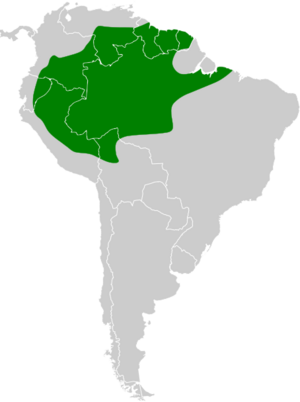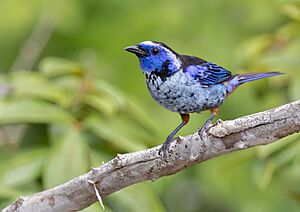Opal-rumped tanager facts for kids
Quick facts for kids Opal-rumped tanager |
|
|---|---|
 |
|
| Conservation status | |
| Scientific classification | |
| Genus: |
Tangara
|
| Species: |
velia
|
 |
|
| Synonyms | |
|
Motacilla velia Linnaeus, 1758 |
|
The opal-rumped tanager (Tangara velia) is a beautiful bird that belongs to the Thraupidae family, which includes many colorful tanagers. You can find this bird living in the huge Amazon and Atlantic Forest areas of South America.
Birds from the Atlantic Forest often have a much lighter chest than other groups. Because of this, they were sometimes thought to be a different species called the silvery-breasted tanager (Tangara cyanomelas). However, most bird experts today agree that it is just a special type, or subspecies, of the opal-rumped tanager.
Discovering the Opal-rumped Tanager
Long ago, in 1743, a British nature expert named George Edwards was one of the first to show the opal-rumped tanager to the world. He drew a picture and wrote about it in his book, A Natural History of Uncommon Birds. He called it the "Red-belly'd Blue-bird."
Edwards' drawing was based on a real bird specimen. This bird belonged to the Duke of Richmond and had been found in a country called Suriname.
How Scientists Name Birds
Later, in 1758, a famous Swedish scientist named Carl Linnaeus updated his important book, Systema Naturae. In this book, Linnaeus gave the opal-rumped tanager its first scientific name, Motacilla velia. He first placed it with wagtails in the genus Motacilla.
Linnaeus used a two-part name, called a binomial name, which is still used today. The first part is the genus name, and the second part is the species name. He didn't explain why he chose "velia" for the species name. It might have been a mistake for an ancient Greek word for a small bird.
Today, the opal-rumped tanager is placed in a different genus called Tangara. This genus was created by a French zoologist named Mathurin Jacques Brisson in 1760. The first place where this type of bird was officially identified, called the type locality, is Suriname.
Different Types of Opal-rumped Tanagers
Scientists recognize four different subspecies of the opal-rumped tanager. These are like different groups within the same species, often found in different areas:
- T. v. velia (Linnaeus, 1758) – This group lives in the Guianas and northern Brazil.
- T. v. iridina (Hartlaub, 1841) – You can find this type in western Amazonia.
- T. v. signata (Hellmayr, 1905) – This subspecies is found in northeastern Brazil.
- T. v. cyanomelas (Wied-Neuwied, 1830) – This group lives in eastern Brazil. This is the one sometimes called the silvery-breasted tanager.



